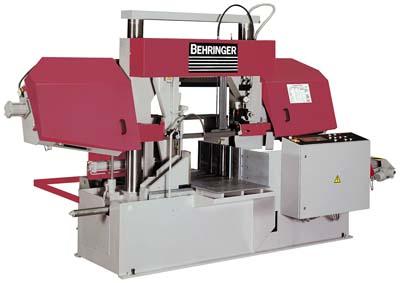
Behringer, a world-class provider of bandsawing machines, circular cold saws and structural fabricating equipment, has introduced the new powerful, high performance HBP-610A bandsaw for cutting large pipes and solid materials up to 24 inches in diameter. The saw frame is a cast iron, dual column design which utilizes positive hydraulic downfeed with a heavy-duty gearbox and a high horsepower motor. The solid cast bow frame is designed to eliminate vibration and provide rigid support for blade tensioning. These design features combine to provide controlled application of downfeed power resulting in precise, accurate movement of the blade and tight tolerances. Cutting accuracy is further enhanced by the horizontal band arrangement and hydraulically tensioned tungsten-carbide guides which provide excellent blade support.
The high torque, frequency-controlled saw drive of the HBP-610A provides cutting speeds from 62 — 426 sq. ft./min. The downfeed power and saw blade pressure are monitored by an automatic pressure sensing system. Cutting pressure data is analyzed and the system automatically makes blade pressure adjustments as needed to assure an optimum balance between feed rate and blade pressure. Operators can maximize material feed rates without concern of overloading the blade. This results in higher output than with saws requiring user-monitored blade pressure. Integrated coolant and hydraulic oil reservoirs assure minimum downtime on routine maintenance which also helps to maintain high production rates.
The cutting accuracy and long bandsaw life are due in particular to the special dual column design. "The dual column downfeed is superior to swing frame and vertical systems because it assures uniform downfeed pressure across the blade with no leverage points," said Joe Suydam, Behringer inside sales engineer. "The cutting path is shorter and therefore cutting is faster and more efficient." Suydam said the new saw features constant chip load removal which facilitates high downfeed rates. This creates a smoother, more even surface on cut pieces according to Suydam.
The HBP-610A bandsaw was developed for the US market to enable automated bandsawing of pipes from 0.75" to 24" in diameter. This size range is commonly used in the natural gas and oil production industries. The saw has an electronically controlled feed gripper that rapidly positions the material for cutting, then floats away from the material. This prevents the gripper from dragging against the material being cut which could interfere with accurate measuring. The gripper clamping jaws automatically adjust to accommodate material diameter. Because the gripper may be positioned very close to the saw blade, remnant lengths are generally shorter which, over time, results in significant savings on material.
All machine functions are controlled by a programmable logic controller with a BT-41 operator terminal for data entry, storage and diagnostic display. An NC preselect provides storage for up to ten programs. Saw frame height adjustment is automatic which saves time by eliminating extra inches of movement each time new material is fed into the saw. The blade moves only the distance actually needed thereby minimizing non-cutting time before high-speed precision cutting resumes.
Contact Details
Related Glossary Terms
- bandsaw
bandsaw
Machine that utilizes an endless band, normally with serrated teeth, for cutoff or contour sawing. See saw, sawing machine.
- bandsaw blade ( band)
bandsaw blade ( band)
Endless band, normally with serrated teeth, that serves as the cutting tool for cutoff or contour band machines.
- bandsawing
bandsawing
Long, endless band with many small teeth traveling over two or more wheels (one is a driven wheel, and the others are idlers) in one direction. The band, with only a portion exposed, produces a continuous and uniform cutting action with evenly distributed low, individual tooth loads. Often called band machining.
- coolant
coolant
Fluid that reduces temperature buildup at the tool/workpiece interface during machining. Normally takes the form of a liquid such as soluble or chemical mixtures (semisynthetic, synthetic) but can be pressurized air or other gas. Because of water’s ability to absorb great quantities of heat, it is widely used as a coolant and vehicle for various cutting compounds, with the water-to-compound ratio varying with the machining task. See cutting fluid; semisynthetic cutting fluid; soluble-oil cutting fluid; synthetic cutting fluid.
- feed
feed
Rate of change of position of the tool as a whole, relative to the workpiece while cutting.
- numerical control ( NC)
numerical control ( NC)
Any controlled equipment that allows an operator to program its movement by entering a series of coded numbers and symbols. See CNC, computer numerical control; DNC, direct numerical control.
- sawing machine ( saw)
sawing machine ( saw)
Machine designed to use a serrated-tooth blade to cut metal or other material. Comes in a wide variety of styles but takes one of four basic forms: hacksaw (a simple, rugged machine that uses a reciprocating motion to part metal or other material); cold or circular saw (powers a circular blade that cuts structural materials); bandsaw (runs an endless band; the two basic types are cutoff and contour band machines, which cut intricate contours and shapes); and abrasive cutoff saw (similar in appearance to the cold saw, but uses an abrasive disc that rotates at high speeds rather than a blade with serrated teeth).
